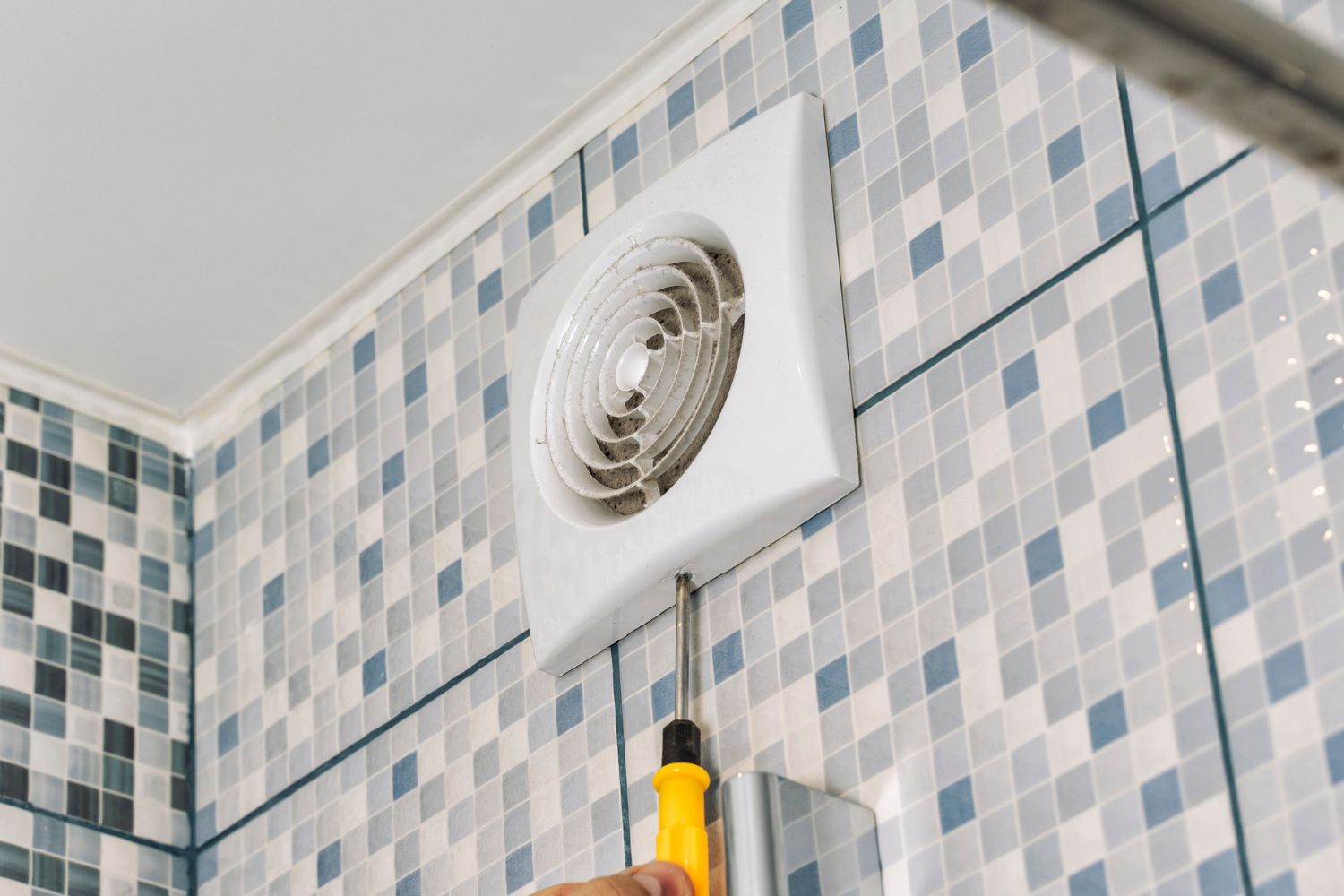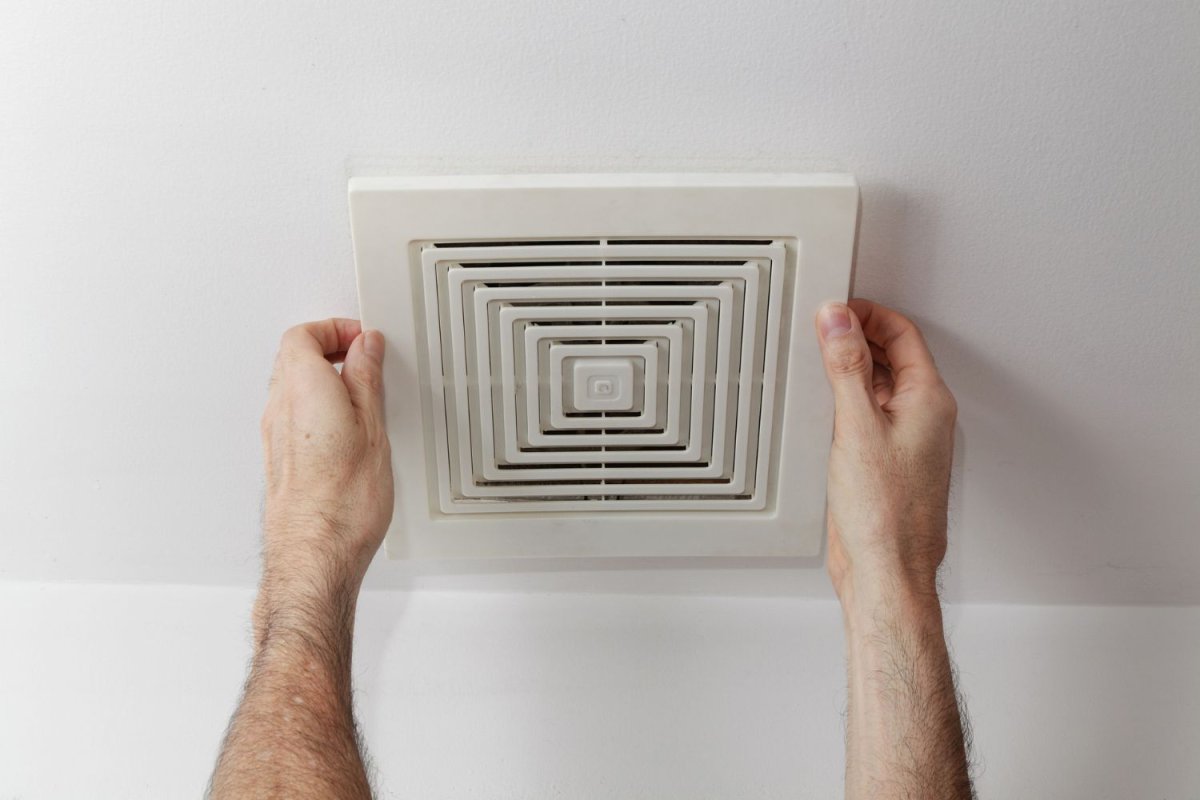We may earn revenue from the products available on this page and participate in affiliate programs. Learn More ›
What You Need to Know
- An electrician can install a bathroom exhaust fan—especially if wiring work is needed.
- An HVAC technician can install or repair bathroom exhaust fan ductwork.
- If the exhaust fan will be vented through the roof, a roofing contractor can help.
- A qualified handyperson or general contractor may also be able to install an exhaust fan in a bathroom.
Q: The exhaust fan in my primary bathroom doesn’t seem to be working correctly, and I want it replaced. Who installs bathroom exhaust fans? Is this a job I can tackle myself?
A: The answer to who installs exhaust fans is more complex than a homeowner might think. Before searching online for “bathroom vent installation near me,” know that a licensed electrician, plumber, or HVAC technician can likely replace an existing exhaust fan or install a new one in a bathroom. However, who you call depends on how the bathroom is set up and whether the job is a simple replacement or if it requires new ductwork or access to the roof. So who can install a bathroom exhaust fan? Find out the right professional for your needs below.

An electrician should replace a bathroom exhaust fan if any wiring needs to be done or if you’re installing a fan where there wasn’t one before.
If there is blank space on the ceiling where a homeowner wants an exhaust fan to go, a licensed electrician can be who to hire to install a bathroom fan. A new fan will require new wiring to be installed, and anything requiring electrical work is best left to an electrician to protect residents’ safety and minimize the risk of home damage. Modern exhaust fans often include a light to increase the bathroom’s brightness while removing excess moisture or unwanted odors. A professional electrician is a good choice for bathroom exhaust fan installation, whether it’s installing a new fan or replacing an old one
If the ductwork needs to be fixed, consider an HVAC technician.
Homeowners may think of an HVAC technician as someone who mainly works on heating and air conditioning systems. While that is true, these experts also handle projects that deal with ductwork, such as stovetop vents, dryers, or in this case, a bathroom exhaust fan. If a homeowner needs to know who to hire to vent a bathroom exhaust fan, the answer is most likely an HVAC technician. Although not every bathroom fan will require ductwork, the ones that do will need to be vented by a professional to ensure air is transported out of the bathroom correctly.
A roofer’s skills may be required if access to the attic or roof is needed to install a bathroom vent.
A home’s setup may require the exhaust fan to be vented to the roof. Or, if an existing fan is being replaced, the installer may need access to the attic or roof if that’s where the fan vents. In these instances, a roofer may be the pro to call to install a bathroom exhaust fan. They’ll know if any specific codes or requirements need to be met when putting the new fan in, and they’ll also have the tools and equipment to do the job themselves.
A handyperson or general contractor may be able to replace a bathroom exhaust fan, but they’ll need to be proficient with HVAC and electrical wiring.
This job may seem simple, but any project that requires the handling of electrical wiring or ductwork should be completed by someone familiar with both. So while a homeowner may be tempted to save money by hiring a handyperson instead of a licensed electrician, plumber, or HVAC technician, the job may end up costing more in the long run if it isn’t done right the first time. In fact, a faulty installation job may end up causing damage to the home if excess moisture isn’t moved out of the room properly or faulty wiring creates a fire hazard. If a homeowner decides to hire a handyperson or a general contractor, it’s wise to ask them about their experience with HVAC and electrical wiring to ensure they know how to install a bathroom fan.

If your bathroom exhaust fan doesn’t seem to be working or is more than 10 years old, consider replacing it.
Today’s exhaust fans are far more efficient than those from years past, so it’s wise to consider replacing a dated or faulty fan. If a homeowner has an older fan in a bathroom that doesn’t get used very often, they may be able to get by for a while without replacing it. However, a busy bathroom that gets a lot of traffic from multiple household members will need a fan that works well. A new bathroom exhaust fan is a basic upgrade that can improve a bathroom for a fraction of the cost of other upgrades (such as new fixtures or tiles).
Installing a bathroom exhaust fan requires choosing the right fan and the right spot in the room.
Before searching for bathroom exhaust fan installers, it’s wise for a homeowner to decide where they’d like the fan to go and which type of fan will work best for the bathroom. If a homeowner is unsure what type of fan they need or where it should be located, they can read tips on bathroom fan installation or visit the local hardware store to get input from a customer service representative. A larger bathroom will need a fan with a larger cubic feet per minute (cfm) rating, while checking the label to see a fan’s sones (which is how loud the fan is) will indicate how loud it will be when it’s turned on. If a homeowner prefers a quieter fan, it’s best to look for one with 2 or less sones.
Bathroom exhaust fans are rated by the unit’s ability to move air.
So how does someone know which exhaust fan is the most efficient or which one will work best for a large or small bathroom? The answer to those questions lies in the fan’s cfm rating, which measures how well the fan moves air out of a bathroom. A bathroom exhaust fan with a cfm rating of 40 to 79 works best for a bathroom that measures anywhere from 40 to 79 square feet, whereas a fan with a cfm rating of 150 to 200 will work best for a 150-plus square foot bathroom. The higher the cfm rating, the more it will likely cost, but the better the unit will perform.
A bathroom exhaust fan unit can cost as little as $20 or as much as $500.
Exhaust fans themselves are on the lower end of the home improvement cost spectrum, ranging from $20 to $80 for the most basic units. However, fans get more expensive when adding more bells and whistles such as lights, Bluetooth capabilities, heaters, humidity sensors, and timers. Some fans can cost as much as $500, excluding the labor to install them. If a homeowner hires an electrician as the exhaust fan installer, they can expect to pay anywhere from $50 to $100 per hour of labor.
Ensure that the professionals you hire are properly licensed and insured.
Searching for “who can install a bathroom fan” can bring up results for local electricians or HVAC technicians who can tackle this task. If you don’t already have one of these experts on your contact list, you’ll want to get references or search for professionals with good track records and reviews. Not only that, but it’s best to ensure whomever is hired has proper licenses and insurance in place, since they’ll likely be working with the home’s wiring or ductwork. A general liability insurance policy, which is something any professional working in your home should have, will not only cover the installer in the event of an accident, but it will also ensure they are responsible for repairs should their work be faulty or cause damage to your home. The safety of you, your home, and the installer is worth the effort in ensuring their credentials.


